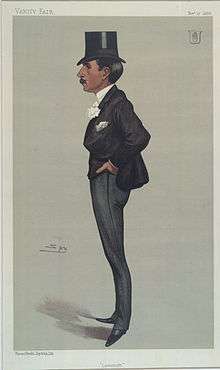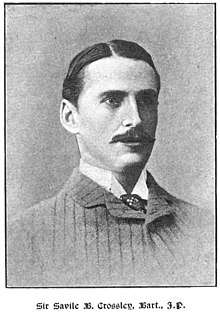Savile Crossley, 1st Baron Somerleyton
Savile Brinton Crossley, 1st Baron Somerleyton GCVO PC (14 June 1857 – 25 February 1935), known as Sir Savile Crossley, Bt, from 1872 to 1916, was a British Liberal Unionist politician who served as Paymaster General from 1902 to 1905.
The Lord Somerleyton GCVO PC | |
|---|---|
 "Lowestoft". Caricature by Spy published in Vanity Fair in 1888. | |
| Paymaster General | |
| In office 11 March 1902 – 4 December 1905 | |
| Monarch | Edward VII |
| Prime Minister | Arthur Balfour |
| Preceded by | The Duke of Marlborough |
| Succeeded by | Richard Causton |
| Personal details | |
| Born | 14 June 1857 |
| Died | 25 February 1935 (aged 77) |
| Nationality | British |
| Political party | Liberal Unionist |
| Spouse(s) | Phyllis de Bathe (1869-1948) |
Background
Crossley was the only son of the businessman and Liberal politician Sir Francis Crossley, 1st Baronet, and his wife Martha Eliza, daughter of Henry Brinton.[1]
Political career
Crossley was elected to parliament for Lowestoft in 1885, as a Liberal. In 1886 he joined the Liberal Unionists and held the seat until 1892 when he chose not to stand again for Lowestoft.[2]

In 1897 Crossley stood as a Liberal Unionist in a by-election for Halifax. He failed that time but stood again in Halifax in the 1900 general election and won the seat.[3] He was appointed High Sheriff of Suffolk for 1896–97.[4]
Crossley was involved in work regarding the National Coronation gift from the people to their new monarch King Edward VII, and was present as it was awarded to the King two days after the coronation, on 11 August 1902. For his service, he was invested as a Member (fourth class) of the Royal Victorian Order (MVO).[5][6]
In August 1902 he was appointed Paymaster General[7] in the Conservative government of Arthur Balfour and was admitted to the Privy Council in December of the same year.[8] He remained in this post until the government fell in December 1905, and he lost his seat in the 1906 general election that followed shortly after. Crossley was never to re-enter the House of Commons.
However, in 1916 he was raised to the peerage as Baron Somerleyton, of Somerleyton in the County of Suffolk.[9] Two years later he was appointed a Lord-in-waiting (government whip) in the coalition government of David Lloyd George. The coalition fell in 1922, but Somerleyton remained as a whip also in the Conservative administrations of Bonar Law and Stanley Baldwin. However, after the first Baldwin government fell in 1924, he was never to hold ministerial office again.
Military and civic appointments
Crossley held the appointment of honorary major in the Army. He was on 2 April 1893 appointed a captain in The Prince of Wales's Own Norfolk Artillery, a Militia Battalion stationed at Great Yarmouth in Norfolk.[10] He volunteered for active service in South Africa during the Second Boer War, and was on 10 March 1900 appointed captain in the Imperial Yeomanry and attached to its 18th battalion.[11] In early May 1902 he was back as a captain in the Norfolk Artillery.[12] He was promoted to the substantive rank of major and honorary lieutenant-colonel of the battalion later the same month,[13] and later served as lieutenant-colonel commanding the Battalion.
Family
Lord Somerleyton married Phyllis de Bathe, daughter of General Sir Henry Percival de Bathe, in 1887. He died in February 1935, aged 77, and was succeeded in the baronetcy and barony by his eldest son, Francis Savile Crossley. His younger son, John, was the father of Belinda Douglas-Scott-Montagu, Baroness Montagu of Beaulieu. Lady Somerleyton died in 1948.[1]
References
- Kidd, Charles, Williamson, David (editors). Debrett's Peerage and Baronetage (1990 edition). New York: St Martin's Press, 1990,
- leighrayment.com House of Commons: London University to Lymington
- leighrayment.com House of Commons: Hackney to Harwich
- "No. 26720". The London Gazette. 10 March 1896. p. 1596.
- "Court Circular". The Times (36844). London. 12 August 1902. p. 8.
- "No. 27467". The London Gazette. 22 August 1902. p. 5461.
- leighrayment.com Peerage: Slim to Stamfordham
- "No. 27504". The London Gazette. 16 December 1902. p. 8663.
- "No. 29651". The London Gazette. 4 July 1916. p. 6597.
- Hart′s Army list, 1901
- "No. 27172". The London Gazette. 9 March 1900. p. 1630.
- "No. 27431". The London Gazette. 6 May 1902. p. 3016.
- "No. 27471". The London Gazette. 27 May 1902. p. 3462.
External links
- Hansard 1803–2005: contributions in Parliament by Sir Savile Crossley
.svg.png)